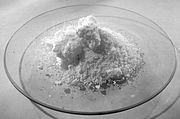Dipotassium phosphate
 | |
 | |
 | |
| Names | |
|---|---|
| IUPAC name Potassium hydrogen phosphate | |
| Other names Potassium monohydrogen phosphate Phosphoric acid dipotassium salt Potassium phosphate dibasic | |
| Identifiers | |
CAS Number |
|
3D model (JSmol) |
|
| ChEBI |
|
| ChEMBL |
|
| ChemSpider |
|
| ECHA InfoCard | 100.028.940 |
| EC Number |
|
| E number | E340(ii) (antioxidants, ...) |
PubChem CID |
|
| UNII |
|
CompTox Dashboard (EPA) |
|
InChI
| |
| |
| Properties | |
Chemical formula | K2HPO4 |
| Molar mass | 174.2 g/mol |
| Appearance | white powder deliquescent |
| Odor | odorless |
| Density | 2.44 g/cm3 |
| Melting point | > 465 °C (869 °F; 738 K) decomposes |
Solubility in water | 149.25 g/100 mL (20 °C) |
| Solubility | slightly soluble in alcohol |
| Acidity (pKa) | 12.4 |
| Basicity (pKb) | 6.8 |
| Hazards | |
| NFPA 704 (fire diamond) |  1 0 0 |
| Flash point | Non-flammable |
| Related compounds | |
Other cations | Disodium phosphate Diammonium phosphate |
Related compounds | Monopotassium phosphate Tripotassium phosphate |
Except where otherwise noted, data are given for materials in their standard state (at 25 °C [77 °F], 100 kPa).  N verify (what is N verify (what is  Y Y N ?) N ?) Infobox references | |
Dipotassium phosphate (K2HPO4) (also dipotassium hydrogen orthophosphate; potassium phosphate dibasic) is the inorganic compound with the formula K2HPO4.(H2O)x (x = 0, 3, 6). Together with monopotassium phosphate (KH2PO4.(H2O)x), it is often used as a fertilizer, food additive, and buffering agent.[1] It is a white or colorless solid that is soluble in water.
It is produced commercially by partial neutralization of phosphoric acid with two equivalents of potassium chloride:[1]
- H3PO4 + 2 KCl → K2HPO4 + 2 HCl
Uses
As a food additive, dipotassium phosphate is used in imitation dairy creamers, dry powder beverages, mineral supplements, and starter cultures.[2] It functions as an emulsifier, stabilizer and texturizer; it also is a buffering agent, and chelating agent especially for the calcium in milk products..[3]
As a food additive, dipotassium phosphate is generally recognized as safe by the United States Food and Drug Administration.[4]
References
- ^ a b Klaus Schrödter; Gerhard Bettermann; Thomas Staffel; Friedrich Wahl; Thomas Klein; Thomas Hofmann (2012). "Phosphoric Acid and Phosphates". Ullmann's Encyclopedia of Industrial Chemistry. Weinheim: Wiley-VCH. doi:10.1002/14356007.a19_465.pub3. ISBN 978-3527306732.
- ^ John H. Thorngate III; Seppo Salminen; Larry A. Branen; Michael P. Davidson, eds. (2001). "Food Phosphates". Food Additives. Food Science and Technology. Vol. 116. CRC Press. doi:10.1201/9780824741709.ch25. ISBN 978-0-8247-9343-2.
- ^ "What is dipotassium phosphate?". 30 April 2018. Retrieved 2020-09-09.
- ^ "Database of Select Committee on GRAS Substances (SCOGS) Reviews". Archived from the original on 2007-05-21. Retrieved 2008-03-22. (listed as "potassium phosphate, dibasic")
- v
- t
- e
| H3PO4 [HPO4]2− [H2PO4]− | He | ||||||||||||||||||||
| Li3PO4 | Be | BPO4 +BO3 | C | (NH4)3PO4 (NH4)2HPO4 NH4H2PO4 -N | O | +F | Ne | ||||||||||||||
| Na3PO4 Na2HPO4 NaH2PO4 | Mg3(PO4)2 | AlPO4 | Si | P | +SO4 -S | Cl | Ar | ||||||||||||||
| K3PO4 K2HPO4 KH2PO4 | Ca3(PO4)2 | ScPO4 | Ti | VPO4 | CrPO4 | Mn3(PO4)2 MnPO4 | Fe3(PO4)2 FePO4 | Co3(PO4)2 | Ni3(PO4)2 | Cu3(PO4)2 | Zn3(PO4)2 | GaPO4 | Ge | As | -Se | Br | Kr | ||||
| Rb3PO4 | Sr3(PO4)2 | YPO4 | Zr3(PO4)4 | Nb | Mo | Tc | Ru | Rh | Pd | Ag3PO4 | Cd3(PO4)2 | InPO4 | Sn | SbPO4 -SbO4 | Te | I | Xe | ||||
| Cs3PO4 | Ba3(PO4)2 | * | LuPO4 | Hf | Ta | W | Re | Os | Ir | Pt | AuPO4 | Hg | Tl3PO4 | Pb3(PO4)2 | BiPO4 | Po | At | Rn | |||
| Fr | Ra | ** | Lr | Rf | Db | Sg | Bh | Hs | Mt | Ds | Rg | Cn | Nh | Fl | Mc | Lv | Ts | Og | |||
| * | LaPO4 | CePO4 | PrPO4 | NdPO4 | PmPO4 | SmPO4 | EuPO4 | GdPO4 | TbPO4 | DyPO4 | HoPO4 | ErPO4 | TmPO4 | YbPO4 | |||||||
| ** | AcPO4 | Th3(PO4)4 | Pa | U(PO4)2 | Np | PuPO4 | AmPO4 | CmPO4 | Bk | Cf | Es | Fm | Md | No | |||||||
 | This food ingredient article is a stub. You can help Wikipedia by expanding it. |
- v
- t
- e










